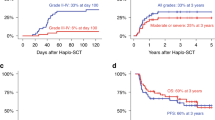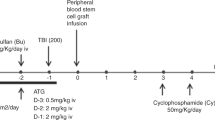Abstract
Hemopoietic stem cell transplantation (SCT) with fully ablative conditioning is associated with an age-related increase in treatment-related mortality. It is therefore particularly unsuited to older individuals, who are most at risk of developing acute myeloid leukemia (AML). Reduced-intensity SCT (RISCT) may be of value in this group. We report 17 consecutive patients with high-risk AML whose median age was 58 years and who received stem cells from HLA-matched siblings (n=5), or alternative donors (n=12). We used lymphodepleting antibodies as a part of the reduced-intensity conditioning regimen to limit the risk of graft rejection and graft-versus-host disease (GVHD). All patients engrafted. One patient developed severe fatal GVHD, and two patients died of infection. At a median follow-up of 861 days (372–1957 days), seven patients are alive in remission, which includes two patients treated in relapse and five patients who lacked an MHC identical sibling donor. Both progression-free survival and overall survival are 40% (95% CI, 17–64%). Hence, RISCT using lymphodepleting antibodies may be of value for older patients with AML, even in those with active or high-risk disease, and even if they lack an MHC-identical sibling donor.
This is a preview of subscription content, access via your institution
Access options
Subscribe to this journal
Receive 12 print issues and online access
$259.00 per year
only $21.58 per issue
Buy this article
- Purchase on Springer Link
- Instant access to full article PDF
Prices may be subject to local taxes which are calculated during checkout


Similar content being viewed by others
References
Lowenberg B, Downing JR, Burnett A . Acute myeloid leukemia. N Engl J Med 1999; 341: 1051–1062.
Dombret H, Chastang C, Fenaux P, Reiffers J, Bordessoule D, Bouabdallah R et al. A controlled study of recombinant human granulocyte colony-stimulating factor in elderly patients after treatment for acute myelogenous leukemia. AML Cooperative Study Group. N Engl J Med 1995; 332: 1678–1683.
Rowe JM, Andersen JW, Mazza JJ, Bennett JM, Paietta E, Hayes FA et al. A randomized placebo-controlled phase III study of granulocyte-macrophage colony-stimulating factor in adult patients (>55 to 70 years of age) with acute myelogenous leukemia: a study of the Eastern Cooperative Oncology Group (E1490). Blood 1995; 86: 457–462.
Stone RM, Berg DT, George SL, Dodge RK, Paciucci PA, Schulman P et al. Granulocyte-macrophage colony-stimulating factor after initial chemotherapy for elderly patients with primary acute myelogenous leukemia. Cancer and Leukemia Group B. N Engl J Med 1995; 332: 1671–1677.
Goldstone AH, Burnett AK, Wheatley K, Smith AG, Hutchinson RM, Clark RE . Attempts to improve treatment outcomes in acute myeloid leukemia (AML) in older patients: the results of the United Kingdom Medical Research Council AML11 trial. Blood 2001; 98: 1302–1311.
Godwin JE, Kopecky KJ, Head DR, Willman CL, Leith CP, Hynes HE et al. A double-blind placebo-controlled trial of granulocyte colony-stimulating factor in elderly patients with previously untreated acute myeloid leukemia: a Southwest oncology group study (9031). Blood 1998; 91: 3607–3615.
Taylor PR, Reid MM, Stark AN, Bown N, Hamilton PJ, Proctor SJ . De novo acute myeloid leukaemia in patients over 55-years-old: a population-based study of incidence, treatment and outcome. Northern Region Haematology Group. Leukemia 1995; 9: 231–237.
Lowenberg B, Suciu S, Archimbaud E, Haak H, Stryckmans P, de Cataldo R et al. Mitoxantrone versus daunorubicin in induction-consolidation chemotherapy – the value of low-dose cytarabine for maintenance of remission, and an assessment of prognostic factors in acute myeloid leukemia in the elderly: final report. European Organization for the Research and Treatment of Cancer and the Dutch-Belgian Hemato-Oncology Cooperative Hovon Group. J Clin Oncol 1998; 16: 872–881.
Leith CP, Kopecky KJ, Godwin J, McConnell T, Slovak ML, Chen IM et al. Acute myeloid leukemia in the elderly: assessment of multidrug resistance (MDR1) and cytogenetics distinguishes biologic subgroups with remarkably distinct responses to standard chemotherapy. A Southwest Oncology Group study. Blood 1997; 89: 3323–3329.
Grimwade D, Walker H, Harrison G, Oliver F, Chatters S, Harrison CJ et al. The predictive value of hierarchical cytogenetic classification in older adults with acute myeloid leukemia (AML): analysis of 1065 patients entered into the United Kingdom Medical Research Council AML11 trial. Blood 2001; 98: 1312–1320.
Horowitz MM, Gale RP, Sondel PM, Goldman JM, Kersey J, Kolb HJ et al. Graft-versus-leukemia reactions after bone marrow transplantation. Blood 1990; 75: 555–562.
Sorror ML, Maris MB, Storer B, Sandmaier BM, Diaconescu R, Flowers C et al. Comparing morbidity and mortality of HLA-matched unrelated donor hematopoietic cell transplantation after nonmyeloablative and myeloablative conditioning: influence of pretransplantation comorbidities. Blood 2004; 104: 961–968.
Sorror ML, Maris MB, Storb R, Baron F, Sandmaier BM, Maloney DG et al. Hematopoietic cell transplantation-specific comorbidity index: a new tool for risk assessment before allogeneic HCT. Blood 2005; 106: 2912–2919.
Krance RA, Kuehnle I, Rill DR, Mei Z, Pinetta C, Evans W et al. Hematopoietic and immunomodulatory effects of lytic CD45 monoclonal antibodies in patients with hematologic malignancy. Biol Blood Marrow Transplant 2003; 9: 273–281.
Wulf GG, Luo KL, Goodell MA, Brenner MK . Anti-CD45-mediated cytoreduction to facilitate allogeneic stem cell transplantation. Blood 2003; 101: 2434–2439.
Marubini E, Valsecchi MG . Analysing Survival Data from Clinical Trials and Observational Studies. John Wiley: New York, NY, 1996.
Heslop HE, Stevenson FK, Molldrem JJ . Immunotherapy of hematologic malignancy. Hematology (Am Soc Hematol Educ Program) 2003, 331–349.
Rousseau R, Biagi E, Yvon E, Zhuyong M, Shannon I, Donna R et al. Treatment of high-risk acute leukemia with an autologous vaccine expressing transgenic IL-2 and CD40L. Blood 2002; 100: 867a.
Morris EC, Rebello P, Thomson KJ, Peggs KS, Kyriakou C, Goldstone AH et al. Pharmacokinetics of alemtuzumab used for in vivo and in vitro T-cell depletion in allogeneic transplantations: relevance for early adoptive immunotherapy and infectious complications. Blood 2003; 102: 404–406.
Waller EK, Langston AA, Lonial S, Cherry J, Somani J, Allen AJ et al. Pharmacokinetics and pharmacodynamics of anti-thymocyte globulin in recipients of partially HLA-matched blood hematopoietic progenitor cell transplantation. Biol Blood Marrow Transplant 2003; 9: 460–471.
Popat U, Carrum G, May R, Lamba R, Krance RA, Heslop HE et al. CD52 and CD45 monoclonal antibodies for reduced intensity hemopoietic stem cell transplantation from HLA matched and one antigen mismatched unrelated donors. Bone Marrow Transplant 2005; 35: 1127–1132.
Kroger N, Bornhauser M, Ehninger G, Schwerdtfeger R, Biersack H, Sayer HG et al. Allogeneic stem cell transplantation after a fludarabine/busulfan-based reduced-intensity conditioning in patients with myelodysplastic syndrome or secondary acute myeloid leukemia. Ann Hematol 2003; 82: 336–342.
Maris MB, Niederwieser D, Sandmaier BM, Storer B, Stuart M, Maloney D et al. HLA-matched unrelated donor hematopoietic cell transplantation after nonmyeloablative conditioning for patients with hematologic malignancies. Blood 2003; 102: 2021–2030.
Wong R, Giralt SA, Martin T, Couriel DR, Anagnostopoulos A, Hosing C et al. Reduced-intensity conditioning for unrelated donor hematopoietic stem cell transplantation as treatment for myeloid malignancies in patients older than 55 years. Blood 2003; 102: 3052–3059.
Sayer HG, Kroger M, Beyer J, Kiehl M, Klein SA, Schaefer-Eckart K et al. Reduced intensity conditioning for allogeneic hematopoietic stem cell transplantation in patients with acute myeloid leukemia: disease status by marrow blasts is the strongest prognostic factor. Bone Marrow Transplant 2003; 31: 1089–1095.
Bertz H, Potthoff K, Finke J . Allogeneic stem-cell transplantation from related and unrelated donors in older patients with myeloid leukemia. J Clin Oncol 2003; 21: 1480–1484.
de Lima M, Anagnostopoulos A, Munsell M, Shahjahan M, Ueno N, Ippoliti C et al. Nonablative versus reduced-intensity conditioning regimens in the treatment of acute myeloid leukemia and high-risk myelodysplastic syndrome: dose is relevant for long-term disease control after allogeneic hematopoietic stem cell transplantation. Blood 2004; 104: 865–872.
Taussig DC, Davies AJ, Cavenagh JD, Oakervee H, Syndercombe-Court D, Kelsey S et al. Durable remissions of myelodysplastic syndrome and acute myeloid leukemia after reduced-intensity allografting. J Clin Oncol 2003; 21: 3060–3065.
Author information
Authors and Affiliations
Corresponding author
Rights and permissions
About this article
Cite this article
Popat, U., Heslop, H., Durett, A. et al. Outcome of reduced-intensity allogeneic hematopoietic stem cell transplantation (RISCT) using antilymphocyte antibodies in patients with high-risk acute myeloid leukemia (AML). Bone Marrow Transplant 37, 547–552 (2006). https://doi.org/10.1038/sj.bmt.1705229
Received:
Revised:
Accepted:
Published:
Issue Date:
DOI: https://doi.org/10.1038/sj.bmt.1705229
Keywords
This article is cited by
-
Fludarabine/i.v. BU conditioning regimen: myeloablative, reduced intensity or both?
Bone Marrow Transplantation (2008)
-
Blood and marrow transplantation in elderly acute myeloid leukaemia patients – older certainly is not better
Bone Marrow Transplantation (2007)
-
Reconstitution of adenovirus-specific cell-mediated immunity in pediatric patients after hematopoietic stem cell transplantation
Bone Marrow Transplantation (2007)



